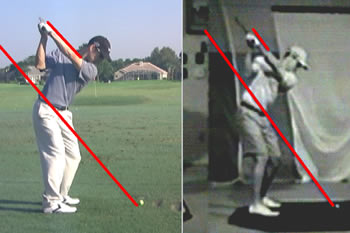An Understanding of Tiger Woods' New Golf Swing
by Chuck Quinton of RotarySwing.com
Updated November 10th, 2009
Watch the Tiger Woods Swing Dynamics Video (seen over 1 million times on YouTube!)
Tiger Woods has gone through some pretty incredible swing changes in the 10 years he has been on the PGA Tour. It's truly been exciting and awe-inspring to watch. When Tiger first came out on Tour, his swing looked very different. Jim Hardy referred to his swing as "One Plane" at that time and you can certainly see some one plane traits in him back then. His swing was much shorter and very aggressive, especially with his upper body rotation. He really hit hard with his body to get distance and he also struggled with control of distance and trajectory because of this extreme body speed and the amount he "pushed" from the right side (watch the "Push vs. Pull" video for more info).
As Tiger progressed with then instructor Butch Harmon, his golf swing morphed into the swing that we all came to admire, especially during his epic run in 2000. His very classic, high hands, wide swing exhibited many pure two plane traits as Jim Hardy would refer to them as and allowed him to develop more ball flight control than few before him. However, his swing was still relatively short at the top with regards to his arm swing, something Tiger felt cost him distance. With the prodigious distances the "youngsters" are hitting the ball these days, Woods felt he needed to make a change to allow his golf swing to become longer while maintaining control. Tiger also places a lot of emphasis on swing plane and felt that this aspect of his swing needed to change as well. Enter Hank Haney.
 |
 |
Enter Hank Haney
Hank Haney has had a long and successful career teaching many fine golfers, most notably Mark O'Meara. Of course, with O'Meara and Woods being close personal friends, it wasn't too difficult for Haney to get a foot in the door with Tiger. Many feel that Haney "stole" Tiger from Butch via O'Meara, however, they actually had known each other since Tiger was a junior golfer. Tiger's switch to Haney was not without its detractors. Many people criticized the work that Haney was doing with Woods and criticized Tiger for leaving what everyone felt was a "perfect" model golf swing. After all, he did win 4 majors in a row with it, why change? And perhaps just as importantly, why Hank Haney?
I'm sure many of you remember an article coming out in Golf Digest back in 2004 or 2005 breaking down Hank Haney's golf swing. The article was quite unique because Haney admitted to playing very little golf over the past 10 years because he had the "yips" with his driver. The swing that Haney concocted for himself to be able to hit the driver again was not pretty to say the least. In fact, it was quite terrible looking and involved him completely looking away from the ball so that he never saw it at impact. For most instructors, coming out in Golf Digest, admitting to not being able to even play golf for the past 10 years as a player and then publishing your very unconventional approach to hitting the big dog would be career suicide. But not for Hank. Not only was it not suicide, it really didn't seem to matter one bit. If the number one player in the world trusts you with his golf swing, that's all you need for credibility in most people's eyes.
That's what prompted me to understand more about Haney's philosophy. Starting in 2004, I researched everything I could, spoke with the director of instruction at his school in Texas, Steve Johnson, and sent him video of my swing. I had also received a video tape from a student of mine that had Tiger working on his swing at Hank Haney's school in Texas. The things that Tiger was doing in his golf swing in regards to swing plane, I had never seen before. It was truly quite remarkable. Not only had I never seen anyone swing that way, I'd never heard anyone really talk about it in depth. Haney mentions some of the things in his book about keeping the club on the same plane, etc., but he certainly didn't go in depth on how to do it. I learned more by watching this 2 second video clip about Haney's theories and Tiger's swing than after reading his book.
One Plane or Two?
So, what is Tiger doing with his new swing, is it a One Plane or Two Plane and is it for you? Those are all the questions I intend to answer in this updated section on Tiger Woods. You see, not only did I learn alot from all my research, but I took it a step further and completely rebuilt my swing to mimic Tiger's. I did this solely in an effort to learn everything I could about this fascinating golf swing and model. Using the tapes I had of Tiger, I had everything I needed to understand what was going on in his swing and felt I could learn the in's and out's of Hank Haney's swing theories and here's why.
I've been studying the golf swing mechanics and physics since 1990. Study is a light term, obsessive dissection is a bit more fair. Over all those years of working under and with different instructors and my stint playing professionally, I learned one valuable thing - most golf instructors have no idea what they are talking about. They all teach based on what they found worked in their own golf swings and what they learned from those around them. This created a scenario that you know all too well today - everyone in the golf instruciton world teaches something different than the next guy. For me, this wasn't good enough. There are fundamentals to everything we do when it comes to athletic movement and I knew the golf swing had to be no different.
From there, I set out on a quest to find the true, objective, unbiased fundamentals to the golf swing based on science, not preference. After many years to of research, working with our Medical Advisory Panel for Rotary Swing Golf, we were at last, able to determine a set of fundamentals, ONE set of fundamentals that is true to all golf swings, and that is exactly what our website, www.RotarySwing.com, is all about. Armed with undeniable fact and understanding about the golf swing, I've been able to recreate Tiger's body movements in my own golf swing because they are based around the laws of anatomy of biomechanics regarding how the body is designed to create rotation around the spine, which is exactly what I teach, ie. the name Rotary Swing.
Armed with proper body movements, I spent a great deal of time looking at Tiger Woods arm movement that he learned under Hank Haney and borrowed some of them. From the Rotary Swing perspective, many of the movements of the arms are variables and we tend to focus on the absolutes of the golf swing, but the movement of the arms is an important aspect of the golf swing. I'm all for minimizing their movement while still ensuring ample speed from them, and Tiger's arm movements weren't far off from being ideal.
-Chuck Quinton, Rotary Swing Golf Founder
So, What is Hank Haney's Swing Model for Tiger Woods?
In it's simplest form, Hank Haney wants the shaft to travel on the same plane, or parallel to that plane, established by the shaft at address. The swing is more rotational in nature than the swing Tiger learned with Butch Harmon, giving it a flattish, laid off look at the top, although it is most certainly NOT laid off. Haney's theory behind all this is that is easier to make a consistent, solid strike and control the clubface if the clubshaft is always on plane.
That's the two second elevator pitch, now let's dive in a little deeper. The following pages are my opinion of what Hank Haney is doing with Tiger Woods based on my study of his golf swing and my research.
Let's start with a look at Tiger's Address Position.
Next, let's look at Tiger's Takeaway.
Next, Tiger's Backswing.
The moment of truth, Tiger at Impact and the Downswing.
Craving more golf instruction? Then visit
http://www.GolfLessonsAndTips.com

















